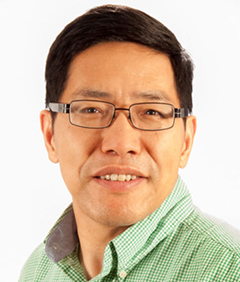UAlbany Atmospheric Scientist Studies the Past to Predict the Future for Greenhouse Gas Effects
ALBANY, N.Y. (June 12, 2014) — Through a new National Science Foundation (NSF) grant, University at Albany atmospheric scientist Aiguo Dai is studying more than a century of climate simulations in order to differentiate natural from man-induced forces affecting global drought and precipitation.
 |
|
Aiguo Dai, of the Department of Atmospheric and Environmental Sciences. |
The study’s results will help interpret recent extreme climate events, such as recent years' droughts and heat waves in the Southwest U.S., and could reveal critical information on how drought brought on by global warming may affect farmers, water resource managers, policymakers and other stakeholders in the U.S. and other countries.
For many climate scientists, determining how global drought and precipitation respond to the greenhouse gas (GHG) effect has been a difficult modeling hurdle. In order to better pinpoint the consequences and enhance future projections, Dai is using observations and model simulations to estimate the “forced response” of land precipitation and drought to GHG and other known forcing factors from 1900 to the present, and for near-future decades using statistical analyses.
“Since climate model simulations represent our best assessment of the externally forced response, we will remove this estimated forced signal from the observed precipitation and drought index fields, so that the remaining part in the observational data can be considered the unforced natural variations,” said Dai, an associate professor in UAlbany’s Department of Atmospheric and Environmental Sciences who has received previous NSF support to study drought and monsoon changes in East Asia.
By comparing unforced natural variations with forced changes over global land, Dai and two UAlbany graduate students will address how much of the observed change in precipitation and drought is due to each of these factors. His team will then use advanced statistical analysis to explore what the characteristics of these forced changes and unforced variations are, as well as atmospheric circulations associated with them.
“This analysis will focus on how decadal variations in tropical and mid-latitude sea surface temperatures and snow cover over Eurasia and North America may influence atmospheric circulation and lead to dry and wet periods over the U.S., Australia, Africa, the Mediterranean region, South and East Asia, and other areas,” said Dai.
Dai will also explore the possibility of improving projections of near-future changes in regional precipitation and drought by combining decadal natural variations with the model-simulated response to future GHG forcing.
He believes an improved understanding of the natural variability in land precipitation and drought will greatly facilitate proper comparisons of observed and model-simulated response of these events to human-induced global warming. This will reduce confusion of natural variations with externally forced changes in comparisons of observed and model-simulated changes.
![]() For more news, subscribe to UAlbany's RSS headline feeds
For more news, subscribe to UAlbany's RSS headline feeds
A comprehensive public research university, the University at Albany-SUNY offers more than 120 undergraduate majors and minors and 125 master's, doctoral and graduate certificate programs. UAlbany is a leader among all New York State colleges and universities in such diverse fields as atmospheric and environmental sciences, business, education, public health,health sciences, criminal justice, emergency preparedness, engineering and applied sciences, informatics, public administration, social welfare and sociology, taught by an extensive roster of faculty experts. It also offers expanded academic and research opportunities for students through an affiliation with Albany Law School. With a curriculum enhanced by 600 study-abroad opportunities, UAlbany launches great careers.


